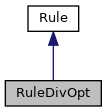Convert INT_MULT and shift forms into INT_DIV or INT_SDIV. More...


Public Member Functions | |
| virtual Rule * | clone (const ActionGroupList &grouplist) const |
| Clone the Rule. More... | |
| virtual void | getOpList (vector< uint4 > &oplist) const |
| List of op codes this rule operates on. More... | |
| virtual int4 | applyOp (PcodeOp *op, Funcdata &data) |
| Attempt to apply this Rule. More... | |
 Public Member Functions inherited from Rule Public Member Functions inherited from Rule | |
| Rule (const string &g, uint4 fl, const string &nm) | |
| Construct given group, properties name. More... | |
| bool | checkActionBreak (void) |
| Check if an action breakpoint is turned on. More... | |
| virtual void | reset (Funcdata &data) |
| Reset this Rule. More... | |
| virtual void | resetStats (void) |
| Reset Rule statistics. More... | |
| virtual void | printStatistics (ostream &s) const |
| Print statistics for this Rule. More... | |
Static Public Member Functions | |
| static Varnode * | findForm (PcodeOp *op, int4 &n, uintb &y, int4 &xsize, OpCode &extopc) |
| Check for INT_(S)RIGHT and/or SUBPIECE followed by INT_MULT. More... | |
Additional Inherited Members | |
 Public Types inherited from Rule Public Types inherited from Rule | |
| enum | typeflags { type_disable = 1, rule_debug = 2, warnings_on = 4, warnings_given = 8 } |
| Properties associated with a Rule. More... | |
Detailed Description
Convert INT_MULT and shift forms into INT_DIV or INT_SDIV.
The unsigned and signed variants are:
sub( (zext(V)*c)>>n, 0) => V / (2^n/(c-1))sub( (sext(V)*c)s>>n, 0) => V s/ (2^n/(c-1))
Member Function Documentation
◆ applyOp()
◆ clone()
|
inlinevirtual |
◆ findForm()
|
static |
Check for INT_(S)RIGHT and/or SUBPIECE followed by INT_MULT.
Look for the forms:
sub(ext(X) * #y,#c)orsub(ext(X) * #y,#c) >> nor(ext(X) * #y) >> n
Looks for truncation/multiplication consistent with an optimized division. The truncation can come as either a SUBPIECE operation and/or right shifts. The numerand and the amount it has been extended is discovered. The extension can be, but doesn't have to be, an explicit INT_ZEXT or INT_SEXT. If the form doesn't match NULL is returned. If the Varnode holding the extended numerand matches the final operand size, it is returned, otherwise the unextended numerand is returned. The total truncation, the multiplicative constant, the numerand size, and the extension type are all passed back.
- Parameters
-
op is the root of the expression n is the reference that will hold the total number of bits of truncation y will hold the multiplicative constant xsize will hold the number of (non-zero) bits in the numerand extopc holds whether the extension is INT_ZEXT or INT_SEXT
- Returns
- the extended numerand if possible, or the unextended numerand, or NULL
◆ getOpList()
|
virtual |
The documentation for this class was generated from the following files:
- ruleaction.hh
- ruleaction.cc
 1.8.17
1.8.17